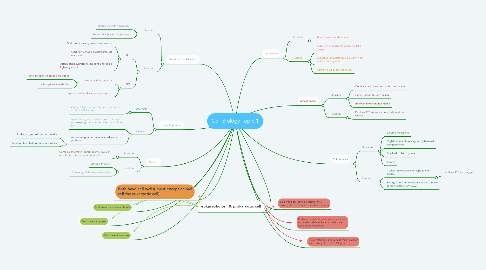
1. Both have cell walls( most except animal cell for eukaryotic cell)
2. Both have ribosomes
3. Both have cytoplasm
4. Both have plasma membrane
5. Endoplasmic Reticulum
5.1. Structure:
5.1.1. Rough ER (with ribosomes)
5.1.2. Smooth ER (without ribosomes)
5.2. Function:
5.2.1. RER
5.2.1.1. Sort proteins using membrane vesicle
5.2.1.2. Insert newly made proteins into ER membrane
5.2.1.3. Attach carbohydrates to proteins and lipids ( glycosylation)
5.2.2. SER
5.2.2.1. Provide surface area for
5.2.2.1.1. detoxification of drugs and alcohol
5.2.2.1.2. carbohydrate metabolism
5.2.2.2. synthesis of lipid (esp phospholipids)
6. Golgi Apparatus
6.1. Structure:
6.1.1. stacks of flattened membrane, can have up to 40 to 100 stacks
6.2. Function:
6.2.1. collect and group proteins from ER, send processed groups out to other parts of the cell
6.2.2. carries out post-transitional modification of proteins
6.2.2.1. Adding sugar residues to proteins
6.2.2.2. Adding phosphate groups to proteins
7. Nucleus
7.1. Structure:
7.1.1. Contains chromatin, chromosome, nuclear membrane, nuclear pore, nucleolus
7.2. Function:
7.2.1. Storage of DNA
7.2.2. Assembly of ribosomal subunits
8. eukaryotic cell & prokaryotic cell
9. Prokaryotic cell (0.2-2μm) is much smaller than eukaryotic cell(10-100μm)
10. Eukaryotic cell have a nucleus while prokaryotic cell contain a nucleoid region
11. Prokaryotic cells do not have specialised organelles while eukaryotic cells have specialised organelles
12. Chloroplasts
12.1. Structure:
12.1.1. Double membrane
12.1.2. Thylakoid membrane system ( flattened compartment)
12.1.3. Stacked to form grana
12.1.4. Stroma
12.2. Function:
12.2.1. Contain chloroplasts to capture light energy
12.2.1.1. produce ATP and oxygen
12.2.2. Energy from light reaction is used to make carbohydrates from CO2
13. Mitochondria
13.1. Structure:
13.1.1. Contains both inner and outer membrane
13.1.2. Highly folded to form cristae
13.1.3. Enclose mitochondrial matrix
13.2. Function:
13.2.1. Produce ATP via cellular respiration at the cristae
14. Lysosomes
14.1. Structure:
14.1.1. Membrane-bound vesicles
14.2. Function:
14.2.1. digestion of macromolecules by lytic enzymes
14.2.2. Digestion of substances brought in the cell via endocytosis
14.2.3. Recycling worn out organelles
